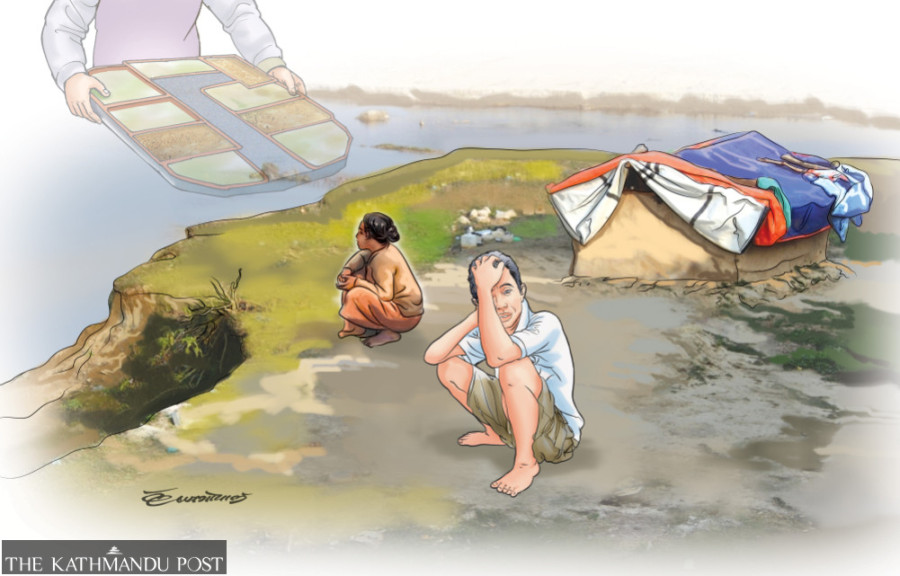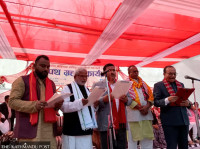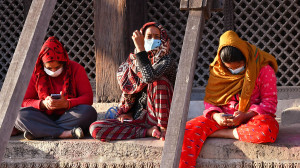National
Land commissions come and go, but issues of landless remain
Records show around 46,000 bighas (30,820 hectares) have been distributed to some 150,000 families in three decades.
Binod Ghimire
In October last year, the government reconstituted the Land Issues Resolving Commission to once and for all address the issues of landless squatters and unmanaged settlements.
All the district-level subordinate offices were also revived the following month. The government and the commission’s officials have been claiming this mechanism will settle the long-standing problems, eliminating the need to form such mechanisms in the future.
The commission, led by CPN-UML leader Hari Prasad Rijal, is the 16th such body formed after the restoration of democracy in 1990 to resettle landless squatters. Yet, contrary to the claims, the commission doesn’t seem to be heading in the direction of permanently resolving the problem. Since its formation eight months ago, it has been collecting applications from hundreds of local units.
On Thursday, it issued a call through the local units in 56 districts to apply for land ownership, if they haven’t already done so. A similar notice was issued by the local units a few weeks back.
“We will call yet another notice in August, which will be the last call,” Sanat Karki, spokesperson and vice-chair at the commission, told the Post. “While we will continue to accept applications, we will also expedite distribution of land ownership certificates.”
Landless squatters and unmanaged inhabitants—those who own land in more than one place but don’t have ownership certificates—can apply through the respective wards in which they reside. Each local government, after verifying that the applicants are genuine, recommends to the commission’s district committees handover of the land. The commission, after further verification, distributes the land ownership certificates.
As per the commission's record, it has received 1,110,985 applications — most of them passed on by the previous commission. Of them, 87,8444 applications are from landless Dalits, 166,395 from landless squatters, and a whopping 856,746 are unmanaged settlers. The numbers are going to increase by the time applications close.
So far, the commission has distributed 4,839 land ownership certificates, the majority of which were issued by the previous commission formed by the erstwhile government.
Commission officials claim there are no problems with land distribution in most places, but have doubts about the Kathmandu Valley. “The landless people residing on the riverbanks and roadsides in the Valley do not want to move far. And there are no places to relocate them near their current settlements,” said Karki.
“We don’t have a mandate to build apartments to house such people.”
Karki had no clear answer as to how the commission would permanently end the landless problem if it had no solution for squatters in the federal capital.
“The government should find a way out in such cases,” said Karki. This means the commission, against the claim, will not resolve the problem permanently.
The commission’s eight-month report card shows it already lags behind the plan. Against the target of distributing 50,000 land ownership certificates by the end of the current fiscal year, it has managed to hand out just 400 such certificates in Banke, Chitwan, and Jhapa. Just a month is left for the deadline.
As per the government records, among the 16 commissions formed, only seven actually distributed land plots, to thousands of families, in the past three decades.
The Krishna Prasad Bhattarai government in 1990 had first formed a mechanism to address the problems faced by the country’s landless people.
But even before the commission could start its work, a new government was formed. The Girija Prasad Koirala-led government dissolved the previous commission and formed a new one led by Shailaja Acharya, a Congress leader.
The Acharya-led commission was the first to start the work of land distribution in earnest. Thereafter, Rishi Ram Lumsali, Buddhiman Tamang, Tarini Datta Chataut, Mohmmad Aftab Alam and Gopal Mani Gautam led various commissions and distributed land to the landless at different times.
The Lumsali Commission was formed during the nine-month government led by the UML in 1995. It gets the credit for distributing the largest chunk of land to the landless so far—21,900 bigha of land (14,673 hectares) among 58,340 families.
The Alam-led commission in 2001 distributed 9,500 bigha (6,365 hectares) to over 15,000 families, the second highest after the Lumsali Commission.
Records at the land management ministry show that around 46,000 bigha of land (30,820 hectares) have been distributed to some 150,000 families in the past three decades. However, tens of thousands of families are still landless.
As per the working procedure of the incumbent commission, it will distribute 130 square meters of land in the Kathmandu Valley and 320 square meters in the rest of the country.
Similarly, the landless are eligible to get 1.5 bigha of land (6772.41 square meters) if they have been cultivating a piece of land for years. They, however, will have to pay a certain amount, which could be around 15 percent of the market price, for the land exceeding 1.5 bigha.




 13.12°C Kathmandu
13.12°C Kathmandu













%20(1).jpg&w=300&height=200)

